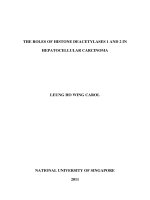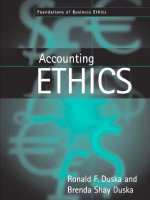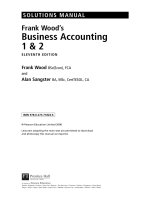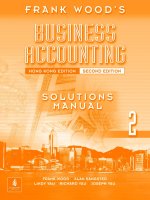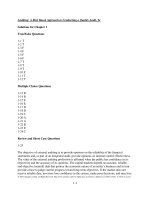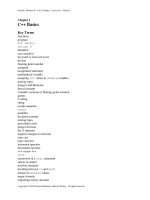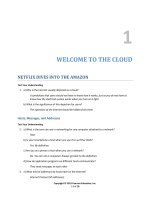Manual of business accounting 1 and 2 11e by frank wood
Bạn đang xem bản rút gọn của tài liệu. Xem và tải ngay bản đầy đủ của tài liệu tại đây (680.6 KB, 206 trang )
SOLUTIONS MANUAL
Frank Wood’s
Business Accounting
1&2
ELEVENTH EDITION
Frank Wood BSc(Econ), FCA
and
Alan Sangster BA, MSc, CertTESOL, CA
ISBN 978-0-273-71824-6
© Pearson Education Limited 2008
Lecturers adopting the main text are permitted to download
and photocopy this manual as required.
Pearson Education Limited
Edinburgh Gate
Harlow
Essex CM20 2JE
England
and Associated Companies around the world
Visit us on the World Wide Web at
www.pearsoned.co.uk
Eleventh edition published in 2008
© Pearson Education Limited 2008
The rights of Frank Wood and Alan Sangster to be identified
as authors of this Work have been asserted by them in accordance
with the Copyright, Designs and Patents Act 1988.
All rights reserved. Permission is hereby given for the material in this
publication to be reproduced for OHP transparencies and student handouts,
without express permission of the Publishers, for educational purposes only.
In all other cases, no part of this publication may be reproduced, stored in
a retrieval system, or transmitted in any form or by any means, electronic,
mechanical, photocopying, recording, or otherwise without either the prior
written permission of the Publishers or a licence permitting restricted copying
in the United Kingdom issued by the Copyright Licensing Agency Ltd,
Saffron House, 6–10 Kirby Street, London ECIN 8TS.
ISBN 978-0-273-71824-6
10
11
9 8 7 6
10 09 08
5
Printed in Great Britain
4
3
2
1
Contents
Preface
iv
Part 1 Business Accounting 1
Students and examination success
Answers
1
3
6
Part 2 Business Accounting 2
Answers
93
95
Preface
This solutions manual contains answers to all the questions not already answered in Business Accounting 1
and Business Accounting 2. It can be seen that there are a considerable number of questions in both textbooks. About one-half of these have the answers at the back of the relevant textbook, while the remainder
of the answers are contained in this manual.
The result of this is to give a high degree of flexibility in the use of the textbooks. To illustrate the contents
of each chapter, the questions can be used which have answers in the textbook. Any students who are
absent can be told what they have missed and can look up the answers themselves. Students who arrive late
on the course can also be told what work to do and they can check their own progress against the answers
as given. However, quite obviously work must be set, either in class or for homework, for which answers
are not available to students. This manual can therefore be used to check such work.
Whilst every endeavour has been made to show workings quite fully, it must be appreciated that there are
often different ways of getting to the same answer. This manual would be unduly lengthy and complicated if
every version of arriving at the answer were to be shown. The methods chosen are therefore those judged
to be the best from a teaching point of view.
Frank Wood and Alan Sangster
By writing on letterheaded paper of the institution where you teach, giving details of the course for which
you use Business Accounting 1 or Business Accounting 2 with your classes, you can obtain complimentary
copies of this manual. This manual is not available for students, nor is it in any way available for sale to
the general public. It is also available on the lecturer’s password-protected section of the Frank Wood
website at www.pearsoned.co.uk/wood
PART 1
BUSINESS ACCOUNTING 1
Students and examination success
Experienced teachers and lecturers know just as much as we do about this topic. There will, however, be
quite a lot of people reading this who are new to teaching, and who have little experience in understanding how the examiner views things. If we have anything to offer, it is simply that we have, between us,
been concerned with accounting education for many years and have been examiners for several external
examining bodies.
The Notes for Students at the start of both Business Accounting 1 and Business Accounting 2 deal with
examination techniques. Make certain the students read these. Go through these with them. If we all tell
students that what these say is true, then they are more likely to believe us.
How students lose marks
1 Lack of knowledge (obviously) but they throw away marks unnecessarily for all of the following reasons:
(a)
(b)
(c)
(d)
Untidy work, including columns of figures not lined up.
Bad handwriting. Do not make it difficult for the examiner to read and mark.
Lack of headings, dates, sub-totals, etc. in accounting statements.
Not submitting proper workings.
You can only get them to rectify everything under this heading by insisting on them correcting (a), (b),
(c) and (d) from early on in the course. Do not wait until a few weeks before the examination to insist
upon properly laid out and neatly constructed work.
2 Students very often do not follow the rubric on the examination paper. If it asks for two questions only
from Section A, then it means just that. A remarkably high percentage do not follow the instructions per
the rubric.
3 Students fail to answer the questions as set. If, for example, an examiner wants a list, students will lose
marks by giving explanations instead. Students must tackle the question in the prescribed way and not
do it differently. The percentage of students passing examinations would rise dramatically if only we
could correct this failing. A good plan is to get them to highlight the instruction that shows how the
examiner wants the question to be answered, e.g.
List the ways by which . . .
Describe the ways by which . . .
Write a report to the managing director about the ways by which . . .
Discuss how the ways by which . . .
Explain how the ways by which . . .
Then, get them to underline the key words in the rest of the question.
They need as much practice as possible in doing this, especially for essay-type questions.
Practice is even more essential for students for whom English is not their first language.
At the end of this section are 20 essay questions in which we have already highlighted the instruction
and underlined the key words. See if your students can do the same.
4 Poor technique with essay questions. Business Accounting 2, Notes for students, the section headed
‘Answering essay questions’ covers this point. Discuss this with your students who have to tackle essay
questions.
5 Not tackling the required number of questions. I have always found it very difficult to convince students
to get hold of the idea that they will get more marks for five uncompleted questions than they will for four
completed questions, when the examiner has asked for five to be attempted. Time planning is essential.
6 By not tackling the easiest questions first. Years ago, we did quite a lot of research into the results of
students who had followed this advice, compared with those who ignored it. Following the advice produced better results.
7 By simply regurgitating the contents of a textbook in essay answers. For instance, when an examiner set
a question on, say, materiality. Most of the answers simply gave exactly the same examples, word for
word sometimes, that we have given in Business Accounting 1.
Examiners are looking for originality and imagination. Students will get excellent marks if they give
their own examples. A good idea is that, for each of the concepts and conventions, they think up their
own examples before the examination. There are going to be more and more questions on these things
in the years ahead.
Frank Wood and Alan Sangster, Business Accounting 1 & 2 Solutions Manual, 11th Edition
© Pearson Education Limited 2008
3
8 Examiners like to see answers where students realise that all accounting is not found in textbooks, but
exists for the use of businesses. Get them to use examples in essay questions based on what they have
observed in the businesses around them.
For example, a question on ratios and interpretation will often be answered by students just using
figures. They should also say why the figures have changed; what possible causes there might have been.
In their life outside their studies, they should observe how accounting is carried out. They all go at
one time or another to refectories, restaurants, shops, department stores, clothes shops, travel on buses
and trains, etc. They should observe how the money is calculated and collected, what sort of bills or
tickets are given out, how fraud or errors could occur, and so on. They can give this flavour of the real
world in their answers. Believe us, they will get better marks.
Essay questions – how not to misunderstand them
1
2
3
4
5
6
7
8
9
10
11
12
13
14
15
16
17
18
19
20
List the various pieces of information which should be shown on a sales invoice.
Describe what is meant by an imprest system.
Accounting based on historical costs can be misleading. Discuss.
The bookkeeper has said that if an error does not affect trial balance agreement then it cannot affect
anything else very much. You are to write a report to the managing director stating whether or not you
agree with the bookkeeper.
Give five examples of different compensating errors and explain why they cancel each other out.
Explain the differences between the straight line and reducing balance methods of depreciation.
Briefly describe the benefits to be gained from maintaining control accounts.
List six instances of errors which could cause the trial balance totals to disagree.
Name three methods of inventory valuation, and briefly describe any one of them.
‘Without the use of accounting ratios, much of the accounting work already performed would be
wasted.’ Discuss the amount of truth in this statement.
How can retail stores use accounting ratios to help them to plan future inventory levels?
Assess the benefits of double entry as compared with single entry methods of bookkeeping.
Define depreciation and describe how the annual charge is worked out using the straight line method.
For a firm buying goods on credit, how can it calculate the figure of purchases even though a Purchases
Journal has not been kept?
List the differences between the income and expenditure account of a club and the income statement
of a trading concern.
‘It is unsatisfactory for the treasurer of a club to prepare and present to the members only the receipts
and payments account as a summary of the records of the club’s activities for the year.’ Why is this true?
What is the better thing to do?
You are to give your advice to the managing director of a company on the best manner of constructing
departmental income statements.
How do the financial statements of a partnership vary from those of a sole trader, and why?
Consider the view that if profit was not calculated at all until the business was closed down, then such
a calculation would be a simple and straightforward affair.
You are to write a letter to a friend explaining in simple terms why profit does not necessarily mean
that you have cash in the bank.
Practice on past full examination papers
If students have not tackled past papers, under as near examination conditions as possible, they will often
get quite a shock when they first sit an accounting examination.
This very often is due to two main reasons:
(a) There is such a lot to do in such a short time.
(b) Even though there is so much to do, in professional examinations in particular, many of the questions
are quite difficult with some complicated calculations or adjustments.
If students can attempt, say, at least two such papers and then have their attempts marked and criticised,
they will normally learn a lot from the experience.
Examination questions and marking schemes
We had originally intended to put here some typical examination questions and their marking schemes.
However, after some considerable thought, we decided against doing so. There is no one precise mode of
marking and any suggestions that we might make could perhaps create more arguments and consequent
misunderstandings.
4
Frank Wood and Alan Sangster, Business Accounting 1 & 2 Solutions Manual, 11th Edition
© Pearson Education Limited 2008
In front of a group of people, it would be possible to do this, as we could deal with all the comments
from the group and arrive at a consensus of opinion. However, the books sell world-wide and practices
can vary.
It can, however, be said that:
(a) By and large, marking is ‘positive’, i.e. marks are awarded for what a student gets right, rather than
being deducted for what a student gets wrong.
(b) However, marks are deducted for untidy work, lack of headings, dates, sub-totals, etc.
(c) An incorrect part of an answer, with no workings attached to it, will get nil marks.
(d) Extra, unnecessary answers, resulting from students failing to follow the rubric, will not be marked.
(e) Not following the examiner’s instructions will lose marks. For example, marks will be lost if, when
asked for a ‘report’, a student gives a ‘list’; or if asked to ‘discuss’, a student gives only one side of the
argument; or if asked to ‘define’, a student gives an ‘explanation’. Some examiners will award zero
marks, even though the answers given by the student show good knowledge of the topic. Others
(including ourselves) would be kinder than that.
(f ) An error which repeats itself through an answer should lose only one set of marks. For instance, an
error in the trading account will also affect balances in the profit and loss account, appropriation
account and balance sheet. In cases of this type, only one set of marks should be lost.
(g) Guessing by students is not normally penalised. The one exception that may arise concerns multiple
choice questions where wrong answers may be penalised as an incentive to prevent students guessing.
In this case, the examining body would make this information known well in advance of the examination date.
(h) The easiest marks to get, especially in an essay question, are the first few marks.
(i) Good handwriting and well displayed answers will often (although theoretically they should not) get
higher marks than they deserve. This is simply because examiners are human beings with human failings, and work that can be easily marked makes them feel generous.
Frank Wood and Alan Sangster
Frank Wood and Alan Sangster, Business Accounting 1 & 2 Solutions Manual, 11th Edition
© Pearson Education Limited 2008
5
Answers
Answer to Question 1.2A
(a) 38,100
(e) 26,000
(b) 51,600
(f ) 159,000
BA 1
(c) 7,600
Answer to Question 1.4A
Liabilities:
Assets:
(d) 104,100
BA 1
Accounts payable for inventory
Owing to bank
Loan from D Jones
Motor vehicles
Premises
Inventory
Accounts receivable
Cash in hand
Machinery
Answer to Question 1.6A
BA 1
Wrong: Accounts payable, Capital, Machinery, Motor vehicles.
Answer to Question 1.8A
BA 1
Fixtures 1,200 + Van 6,000 + Inventory 2,800 + Bank 200 + Cash 175 = Total Assets 10,375.
Loan 2,500 + Accounts payable 1,600 + Capital (difference) 6,275.
Answer to Question 1.10A
BA 1
M Kelly
Balance Sheet as at 30 June 2006
Non-current assets
Equipment
Current assets
Inventory
Accounts receivable
Cash at bank
Less Current liabilities
Accounts payable
3,400
3,600
4,500
2,800
10,900
4,100
Capital
6
6,800
10,200
10,200
Frank Wood and Alan Sangster, Business Accounting 1 & 2 Solutions Manual, 11th Edition
© Pearson Education Limited 2008
Answer to Question 1.12A
Assets
(a) +Van
(b) −Cash
(c) +Inventory
−Bank
(d) +Cash
(e) +Inventory
−Accounts receivable
(f ) +Inventory
(g) −Cash
(h) −Bank
BA 1
Liabilities
+Accounts payable
−Loan from P Smith
Capital
+Capital
+Accounts payable
−Accounts payable
Answer to Question 1.14A
−Capital
BA 1
J Hill
Balance Sheet as at 7 December 2009
Non-current assets
Equipment
Car
6,310
7,300
13,610
Current assets
Inventory
Accounts receivable
Bank
Cash
8,480
3,320
9,510
485
21,795
35,405
Current liabilities
Accounts payable
1,760
33,645
Capital
33,645
Answer to Question 2.2A
Debited
(a) Lorry
(c) Loan from P Logan
(e) Office machinery
(g) Bank
(i) Cash
BA 1
Credited
Cash
Cash
Ultra Ltd
J Cross
Loan from L Lowe
Debited
(b) T Lake
(d) Cash
(f ) Cash
(h) Bank
(j) D Lord
Credited
Bank
Lorry
A Hill
Capital
Cash
To save time and space, the months are omitted in the Ledger accounts which follow. The day of the
month is shown in brackets.
Frank Wood and Alan Sangster, Business Accounting 1 & 2 Solutions Manual, 11th Edition
© Pearson Education Limited 2008
7
Answer to Question 2.5A
(1) Capital
(25) Cash
(5) Old Ltd
(15) Cash
(30) Bank
Bank
16,000
(2)
400 (12)
(19)
(30)
BA 1
Van
6,400
Cash
180
Carton Cars 7,100
Office fixtures 480
Office Fixtures
900
120
480
(12) Bank
(21) Loan: Berry
Cash
180 (15) Office fixtures 120
500 (25) Bank
400
Vans
(2) Bank
6,400
(8) Carton Cars 7,100
Old Ltd
(5) Office fixtures 900
Capital
(1) Bank
16,000
(19) Bank
Carton Cars
7,100
(8) Van
Loan from Berry
(21) Cash
Answer to Question 2.6A
500
BA 1
Bank
(1) Capital
9,000
(8) Cash
(2) Loan Blane 2,000 (15) Loan Blane
(17) Clearcount
(15) Bank
(24) Cash
7,100
Loan: B Blane
500
(2) Bank
250
200
500
420
(1) Capital
(8) Bank
Cash
750
(3) Computer
200 (24) Loan Blane
(3) Cash
Computer
600
600
250
2,000
(17) Bank
Clearcount Ltd
420
(5) Display eqt
420
Display Equipment
(5) Clearcount
420
Capital
(1) Cash
(1) Bank
Answer to Question 3.2A
(a)
(c)
(e)
(g)
(i)
8
Debited
Purchases
L Jones Ltd
Van
Bank
B Henry
750
9,000
(31) F Jones
F Jones
(31) Printer
Printer
200
BA 1
Credited
T Morgan
Machinery
D Davies Ltd
D Picton
Bank
(b)
(d)
(f )
(h)
(j)
Debited
Returns in
Purchases
I Prince
Purchases
J Mullings
Credited
J Thomas
Cash
Returns out
Bank
Sales
Frank Wood and Alan Sangster, Business Accounting 1 & 2 Solutions Manual, 11th Edition
© Pearson Education Limited 2008
200
Answer to Question 3.4A
BA 1
Cash
7,400
(2) Bank
54
(7) Purchases
(1) Capital
(19) Sales
7,000
362
Bank
7,000
(5) Van
4,920
(29) J Watson
368
1,500 (31) Firelighters Ltd820
(2) Cash
(24) F Holmes
(Loan)
Purchases
410
362
(4) J Watson
(7) Cash
Returns Outwards
(12) J Watson
(12) Returns
(29) Bank
J Watson
42
(4) Purchases
368
(10) Sales
L Less
218
Sales
(10) L Less
(19) Cash
42
Fixtures
410
(22) Firelighters
Ltd
(5) Bank
820
Van
4,920
F Holmes (Loan)
(24) Bank
(31) Bank
Firelighters Ltd
820 (22) Fixtures
Capital
(1) Cash
Answer to Question 3.6A
(1) Capital
(18) Cash
Cash
210 (18) Bank
305
B Hind
(6) Returns Out
82
(2) Purchases
(29) Bank
1,373
620
1,373
820
7,400
(10) Sales
P Syme
483 (23) Returns In
160
(22) Sales
H Buchan
394 (25) Returns In
18
A Cobb
(31) Machinery
419
18,000
Purchases
1,455
472
370
Sales
(5)
(10)
(12)
(22)
1,455
472
370
Capital
(1) Bank
(2) B Hind
(3) G Smart
(8) G Smart
250
G Smart
47
(3) Purchases
(8) Purchases
(28) Returns Out
1,500
BA 1
Bank
18,000 (21) Printer
250 (29) B Hind
(5) Sales
(12) Sales
218
54
(23) P Syme
(25) H Buchan
Cash
P Syme
Cash
H Buchan
210
483
305
394
Returns Inwards
160
18
Returns Outwards
(6) B Hind
(28) G Smart
(31) A Cobb
Machinery
419
(21) Bank
Printer
620
Frank Wood and Alan Sangster, Business Accounting 1 & 2 Solutions Manual, 11th Edition
© Pearson Education Limited 2008
82
47
9
Answer to Question 4.3A
July
1 Bank
Cash
Capital
2 Stationery
Bank
3 Purchases
T Smart
4 Cash
Sales
5 Insurance
Cash
7 Computer
J Hott
8 Expenses
Bank
10 C Biggins
Sales
11 T Smart
Returns Out
14 Wages
Cash
17 Rent
Bank
20 Bank
C Biggins
21 J Hott
Bank
23 Stationery
News Ltd
25 F Tank
Sales
31 News Ltd
Bank
10
BA 1
Dr
5,000
1,000
Cr
6,000
75
75
2,100
2,100
340
340
290
290
700
700
32
32
630
630
55
55
210
210
225
225
400
400
700
700
125
125
645
645
125
125
Frank Wood and Alan Sangster, Business Accounting 1 & 2 Solutions Manual, 11th Edition
© Pearson Education Limited 2008
Answer to Question 4.4A
Bank
(1) Capital
11,000
(5)
(24) K Fletcher
250 (16)
(28) Business rates 45 (19)
(28)
(28)
(28)
(1) Capital
Cash
1,600
(3)
(4)
(7)
(11)
(18)
(21)
(23)
BA 1
Stationery
62
Business rates 970
Rent
75
J Biggs
830
D Martin
415
B Black
6,100
Purchases
Rent
Wages
Rent
Insurance
Motor exps
Wages
Capital
(1) Bank
(1) Cash
(4) Cash
(11) Cash
(19) Bank
Rent
75
75
75
(7) Cash
(23) Cash
Wages
160
170
(5) Bank
(16) Bank
(2)
(2)
(2)
(3)
Sales
(6)
(6)
(6)
(15)
(15)
(15)
370
75
160
75
280
24
170
11,000
1,600
D Twigg
B Hogan
K Fletcher
T Lee
F Sharp
G Rae
Returns Outwards
(10) D Martin
(13) B Hogan
B Black
6,100 (20) Van
(28) Bank
J Biggs
830
(2) Purchases
(10) Returns Out
(28) Bank
D Martin
195
(2) Purchases
415
P Lot
(2) Purchases
45
(6) Sales
D Twigg
370
(18) Cash
Insurance
280
(6) Sales
B Hogan
290 (13) Returns In
(21) Cash
Motor Expenses
24
(6) Sales
K Fletcher
410 (24) Bank
(20) B Black
Van
6,100
370
290
410
205
280
426
195
Returns Inwards
35
(28) Bank
Stationery
62
Business rates
970 (28) Bank
Purchases
830
610
590
370
J Biggs
D Martin
P Lot
Cash
(15) Sales
T Lee
205
(15) Sales
F Sharp
280
(15) Sales
G Rae
426
Frank Wood and Alan Sangster, Business Accounting 1 & 2 Solutions Manual, 11th Edition
© Pearson Education Limited 2008
6,100
830
610
590
35
250
11
Answer to Question 4.6A
(A)
(B)
(C)
(D)
(E)
(F)
(G)
(H)
(I)
BA 1
Goods bought on credit £27,000.
Borrowed £35,000 and immediately spent it on land and buildings £35,000.
Sold goods costing £20,000 for £30,000 on credit.
Debtors paid £13,000.
Debtors paid £2,000: this amount taken by proprietors.
Took £5,000 drawings by cheque and paid off £3,000 accrued expenses by cheque.
Equipment costing £30,000 sold for £21,000; paid by cheque.
Goods taken for own use £1,000.
Took £6,000 cash as drawings. Could have been £6,000 cash stolen – thus reducing cash and causing
a loss.
Answer to Question 5.6A
(1) Sales
(21) Sales
(1) Balance b/d
(1) Sales
(8) Sales
(21) Sales
(1) Balance b/d
(1) Sales
(8) Sales
(1) Balance b/d
(1) Sales
BA 1
G Wood
310 (19) Bank
90 (31) Balance c/d
400
310
90
400
(15) Returns
(28) Bank
90
K Hughes
42 (31) Balance c/d
161
430
633
(31) Balance c/d
633
F Dunn
1,100 (10) Returns
31
224 (19) Bank
750
(31) Balance c/d
543
1,324
1,324
543
M Lyons
309 (10) Returns
(12) Cash
309
82
227
309
190
J Leech
278
(2) Purchases
(9) Purchases
278
63
215
278
(1) Balance b/d
633
633
T Sim
15
(2) Purchases
175
190
(28) Bank
(31) Balance c/d
P Tidy
180
(2) Purchases
30
210
(31) Balance b/d
(15)
(28)
(31)
(31)
Returns
Bank
Returns
Balance c/d
F Rock
21
(2) Purchases
100
(9) Purchases
18
215
354
(1) Balance b/d
Wood, Hughes and Dunn are debtors. Leech, Tidy and Rock are creditors.
12
Frank Wood and Alan Sangster, Business Accounting 1 & 2 Solutions Manual, 11th Edition
© Pearson Education Limited 2008
190
278
210
210
30
190
164
354
215
Answer to Question 5.7A
G Wood
Dr
310
2008
May 1
Sales
May 19 Bank
May 21 Sales
310
K Hughes
Dr
42
161
430
Sales
Sales
Returns
Bank
2008
May 1
Sales
May 10 Returns
May 12 Bank
2008
May 2
Purchases
May 15 Returns
May 28 Bank
2008
May 2
May 9
F Dunn
Dr
1,100
224
M Lyons
Dr
309
Cr
Balance
1,100 Dr
1,324 Dr
1,293 Dr
543 Dr
Cr
P Tidy
Dr
Balance
190 Cr
175 Cr
0
Cr
63
215
Balance
63 Cr
278 Cr
Cr
210
Balance
210 Cr
30 Cr
Cr
190
164
Balance
190 Cr
354 Cr
333 Cr
233 Cr
215 Cr
180
F Rock
Dr
Balance
309 Dr
227 Dr
0
Cr
190
15
175
Purchases
Purchases
Purchases
Purchases
Returns
Bank
Returns
Balance
42 Dr
203 Dr
633 Dr
82
227
T Sim
Dr
Balance
310 Dr
0
90 Dr
Cr
31
750
J Leech
Dr
2008
May 2
Purchases
May 28 Bank
2008
May 2
May 9
May 15
May 28
May 31
Cr
90
2008
May 1
Sales
May 8
Sales
May 21 Sales
2008
May 1
May 8
May 10
May 19
BA 1
21
100
18
Frank Wood and Alan Sangster, Business Accounting 1 & 2 Solutions Manual, 11th Edition
© Pearson Education Limited 2008
13
Answer to Question 6.3A
(1)
(28)
(28)
(30)
Capital
T Potts
J Field
Capital
(1) Balance b/d
(5) Sales
(26) Loan from
B Bennet
(1) Balance b/d
(3)
(3)
(3)
(3)
(19)
(19)
(19)
J Small
F Brown
R Charles
T Rae
R Charles
T Rae
F Jack
(1) Balance b/d
(30) Balance c/d
Bank
15,000 (6)
71 (7)
42 (23)
900 (23)
(23)
(25)
(30)
16,013
BA 1
Rent
175
Business rates 130
J Small
272
F Brown
1,200
T Rae
500
Van
6,200
Balance c/d 7,536
16,013
7,536
Cash
610 (17) Wages
(30) Balance c/d
750
1,360
Sales
2,383 (5)
(11)
(11)
(11)
2,383
Cash
T Potts
J Field
T Gray
Returns Outwards
45 (18) J Small
(18) R Charles
45
(1) Balance b/d
(20) J Field
(20) T Potts
(1) Balance b/d
(30) Balance c/d
1,360
Returns Inwards
6 (30) Balance c/d
14
20
3,225
610
85
48
1,640
2,383
18
27
45
45
20
20
15,000
900
15,900
Van
(21) Turnkey Motors 4,950 (30) Balance c/d 11,150
(25) Bank
6,200
11,150
11,150
(6) Bank
(1) Balance b/d
14
11,150
Rent
175 (30) Balance c/d
175
(18)
(23)
(23) Bank
(18) Returns Out
(30) Balance c/d
(30) Balance c/d
(11) Sales
(11) Sales
2,383
(1) Balance b/d 15,900
(1) Balance b/d
(30)
(23) Bank
(30) Balance c/d
20
Capital
15,900 (1) Bank
(30) Bank
15,900
(17)
(1)
3,225
3,225
(1) Balance b/d
(30) Balance c/d
290
1,070
1,070
Purchases
290 (30) Balance c/d
1,200
530
610
110
320
165
3,225
Business rates
130 (30) Balance c/d
130
Wages
Cash
290 (30) Balance c/d
Balance b/d
290
Loan from B Bennet
Balance c/d
750 (26) Cash
(1) Balance b/d
J Small
Returns Out
18 (3) Purchases
Bank
272
290
(7) Bank
(1) Balance b/d
175
F Brown
1,200 (3) Purchases
R Charles
27 (3)
613 (19)
640
(1)
T Rae
500 (3)
430 (19)
930
(1)
F Jack
165 (19)
(1)
T Potts
85 (20)
(28)
85
Purchases
Purchases
Balance b/d
Purchases
Purchases
130
290
750
750
290
290
1,200
530
110
640
613
Balance b/d
610
320
930
430
Purchases
Balance b/d
165
165
Returns In
Bank
14
71
85
J Field
48 (20) Returns In
(28) Bank
48
6
42
48
T Gray
1,640 (30) Balance c/d 1,640
1,640
Turnkey Motors
(30) Balance c/d
4,950 (21) Van
4,950
(1) Balance b/d 4,950
Trial Balance as at 30 November 2007
Bank
7,536
Cash
1,070
Purchases
3,225
Sales
2,383
Returns Outwards
45
Returns Inwards
20
Capital
15,900
Van
11,150
Rent
175
Business rates
130
Wages
290
Loan from B Bennet
750
R Charles
613
T Rae
430
F Jack
165
T Gray
1,640
Turnkey Motors
4,950
25,236
25,236
(11) Sales
(1) Balance b/d
Frank Wood and Alan Sangster, Business Accounting 1 & 2 Solutions Manual, 11th Edition
© Pearson Education Limited 2008
Answer to Question 6.4A
Cash
Capitals
10,500
(2)
Sales
145
(3)
Loan: B Barclay 500 (11)
A Tom
614 (30)
11,759
(1) Balance b/d
1,419
(1)
(21)
(30)
(30)
Bank
Cash
9,000
(8)
Loan: B Barclay2,000 (15)
R Pleat
158 (26)
L Fish
370 (26)
(30)
11,528
(1) Balance b/d
3,790
(2)
(16)
(29)
(29)
(3)
(4)
(4)
(4)
(4)
Cash
T Dry
F Hood
M Smith
G Low
(1) Balance b/d
(30) Balance c/d
(30) Balance c/d
(18) R Tong
(18) M Singh
(1) Balance b/d
BA 1
Bank
Purchases
Salaries
Balance c/d
Rent
Van
F Hood
M Smith
Balance c/d
Purchases
550 (30) Balance c/d
800
930
160
510
2,950
2,950
Sales
1,783
(6)
(6)
(6)
(6)
(21)
(24)
(24)
(24)
1,783
(1)
R Tong
L Fish
M Singh
A Tom
Cash
L Fish
A Tom
R Pleat
9,000
550
790
1,419
11,759
220
6,500
900
118
3,790
11,528
2,950
Balance b/d
Returns Outwards
72 (14) F Hood
(14) M Smith
72
(1) Balance b/d
30
42
72
72
790
(10) Chiefs Ltd
(1) Balance b/d
Fixtures
610 (30) Balance c/d
610
610
(15) Bank
(1) Balance b/d
Van
6,500 (30) Balance c/d
6,500
6,500
Loan from B Barclay
2,500 (16) Bank
(30) Cash
2,500
(1) Balance b/d
2,000
500
2,500
2,500
(30) Balance c/d
Chiefs Ltd
610 (10) Fixtures
(1) Balance b/d
610
610
(6) Sales
(24) Sales
L Fish
240 (29) Bank
130
370
(30) Balance c/d
(6) Sales
(1) Balance b/d
(6) Sales
(24) Sales
(24) Sales
(6) Sales
(14) Returns Out
(26) Bank
(30) Balance c/d
T Dry
800
(4) Purchases
(1) Balance b/d
800
800
(14) Returns Out
(26) Bank
M Smith
42
(4) Purchases
118
160
160
G Low
510
(4) Purchases
(1) Balance b/d
510
510
Buttons Ltd
89
(5) Stationery
(1) Balance b/d
89
89
(5) Buttons Ltd
(1) Balance b/d
Salaries
790 (30) Balance c/d
790
25
10,500
10,500
Stationery
89 (30) Balance c/d
89
(11) Cash
(1) Balance b/d
(1) Balance b/d
(30) Balance b/d
(30) Balance c/d
220
25
Capital
10,500
(1) Cash
(1) Balance b/d
(30) Balance c/d
Rent
220 (30) Balance c/d
220
2,950
170
240
326
204
145
130
410
158
1,783
1,783
Returns Inwards
5 (30) Balance c/d
20
25
25
(8) Bank
(1) Balance b/d
160
89
M Singh
326 (18) Returns In
(30) Balance c/d
326
306
370
370
20
306
326
A Tom
204 (30) Cash
410
614
614
R Pleat
158 (29) Bank
158
R Tong
170 (18) Returns In
(30) Balance c/d
170
170
F Hood
30
(4) Purchases
900
930
Trial Balance as at 31 January 2008
Cash
1,419
Bank
3,790
Purchases
2,950
Sales
Returns Outwards
Returns Inwards
25
Capital
Stationery
89
Rent
220
Salaries
790
Fixtures
610
Van
6,500
Loan from B Barclay
Chiefs Ltd
M Singh
306
R Tong
165
T Dry
G Low
Buttons Ltd
16,864
Frank Wood and Alan Sangster, Business Accounting 1 & 2 Solutions Manual, 11th Edition
© Pearson Education Limited 2008
614
5
165
170
930
930
1,783
72
10,500
2,500
610
800
510
89
16,864
15
Answer to Question 7.3A
BA 1
B Morse
Income Statement for the year ending 31 December 2008
Sales
Less Cost of goods sold:
Purchases
Less Closing inventory
Gross profit
Less Expenses:
Salaries
Business rates
Motor expenses
General expenses
Insurance
Net profit
235,812
121,040
14,486
39,560
2,400
910
305
1,240
Answer to Question 7.4A
106,554
129,258
44,415
84,843
BA 1
G Graham
Income Statement for the year ending 30 June 2008
Sales
Less Cost of goods sold:
Purchases
Less Closing inventory
Gross profit
Less Expenses:
Salaries and wages
Equipment rental
Insurance
Lighting and heating
Motor expenses
Sundry expenses
Net profit
Answer to Question 8.3A
382,420
245,950
29,304
48,580
940
1,804
1,990
2,350
624
216,646
165,774
56,288
109,486
BA 1
B Morse
Balance Sheet as at 31 December 2008
Non-current assets
Premises
Car
53,000
4,300
Current assets
Inventory
Accounts receivable
Bank
Cash
14,486
21,080
2,715
325
38,606
95,906
Total assets
Less Current liabilities
Accounts payable
Capital
Balance at 1.1.2008
Add Net profit
Less Drawings
16
57,300
11,200
84,706
23,263
84,843
108,106
23,400
Frank Wood and Alan Sangster, Business Accounting 1 & 2 Solutions Manual, 11th Edition
© Pearson Education Limited 2008
84,706
Answer to Question 8.4A
BA 1
G Graham
Balance Sheet as at 30 June 2008
Non-current assets
Shop
Fixtures
Lorry
174,000
4,600
19,400
Current assets
Inventory
Accounts receivable
Bank
29,304
44,516
11,346
198,000
85,166
283,166
Current liabilities
Accounts payable
23,408
259,758
Capital
Balance at 1.7.2007
Add Net profit
194,272
109,486
303,758
44,000
Less Drawings
Answer to Question 8.6A
259,758
BA 1
= 18,000 + 4,800 + 24,000 + 760 + 15,600 − 8,000 − 6,000
= 49,160
Capital at 31 December 2009 = 16,200 + 5,800 + 28,000 + 240 + 4,600 + 16,000 − 11,000 − 2,000
= 57,840
Increase in capital
= 8,680
Add Drawings (200 × 52)
10,400
19,080
Less Capital introduced
4,000
Net profit
15,080
Capital at 1 January 2009
A Trader
Balance Sheet as at 31 December 2009
Non-current assets
Fixtures
Motor vehicle
16,200
16,000
32,200
Current assets
Inventory
Accounts receivable
Bank
Cash
28,000
5,800
4,600
240
Current liabilities: Accounts payable
11,000
Non-current liabilities: Loan
2,000
Capital account
Balance at 1 January 2009
Add Capital introduced
Net profit
Less Drawings
Frank Wood and Alan Sangster, Business Accounting 1 & 2 Solutions Manual, 11th Edition
© Pearson Education Limited 2008
38,640
70,840
13,000
57,840
49,160
4,000
15,080
68,240
10,400
57,840
17
Answer to Question 9.2A
BA 1
P Frank
Trading Account part of the Income Statement for the year ending 31 March 2008
Sales
469,320
Less Returns in
16,220
Less Cost of goods sold:
Purchases
394,170
Less Returns out
19,480
374,690
Carriage inwards
2,490
377,180
Less Closing inventory
52,400
Gross profit
Answer to Question 9.5A
453,100
324,780
128,320
BA 1
T Owen
Income Statement for the year ending 31 March 2009
Sales
Less Cost of goods sold:
Opening inventory
Add Purchases
Less Returns out
Carriage inwards
276,400
52,800
141,300
2,408
Less Closing inventory
Gross profit
Less Expenses:
Wages and salaries
Carriage outwards
Business rates
Communication expenses
Commissions paid
Insurance
Sundry expenses
Net profit
138,892
1,350
193,042
58,440
63,400
5,840
3,800
714
1,930
1,830
208
134,602
141,798
77,722
64,076
Balance Sheet as at 31 March 2009
Non-current assets
Buildings
Fixtures
125,000
1,106
126,106
Current assets
Inventory
Accounts receivable
Bank
Cash
58,440
45,900
31,420
276
Current liabilities
Accounts payable
Capital
Balance at 1.4.2008
Add Net profit
Less Drawings
136,036
262,142
24,870
237,272
210,516
64,076
274,592
37,320
237,272
18
Frank Wood and Alan Sangster, Business Accounting 1 & 2 Solutions Manual, 11th Edition
© Pearson Education Limited 2008
Answer to Question 9.6A
BA 1
F Brown
Income Statement for the year ending 30 September 2008
Sales
Less Returns in
Less Cost of goods sold:
Opening inventory
Add Purchases
Less Returns out
Carriage inwards
391,400
2,110
389,290
72,410
254,810
1,240
Less Closing inventory
Gross profit
Less Expenses:
Wages and salaries
Carriage out
Motor expenses
Rent and rates
Telephone charges
Insurance
Office expenses
Sundry expenses
253,570
760
326,740
89,404
39,600
2,850
1,490
8,200
680
745
392
216
237,336
151,954
54,173
97,781
Balance Sheet as at 30 September 2008
Non-current assets
Van
Office equipment
5,650
7,470
Current assets
Inventory
Accounts receivable
Bank
Cash
89,404
38,100
4,420
112
Current liabilities
Accounts payable
132,036
145,156
26,300
118,856
Capital
Balance as at 1.10.2007
Add Net profit
49,675
97,781
147,456
28,600
Less Drawings
Answer to Question 9.8A
13,120
118,856
BA 1
Capital
July 1
Balance b/d
9,700
Balance b/d
Purchases
500
3,900
4,400
1,400
Inventory
July 1 Balance b/d
5,000
OK Ltd
July
July 31
Bank
Balance c/d
3,000
1,400
4,400
July 1
Aug 1 Balance b/d
Frank Wood and Alan Sangster, Business Accounting 1 & 2 Solutions Manual, 11th Edition
© Pearson Education Limited 2008
19
AB Ltd
July 1
Balance b/d
Sales
Aug 1
Balance b/d
300
600
900
600
July
Bank
July 31 Balance c/d
300
600
900
Equipment
July 1
Aug 1
Balance b/d
Balance b/d
3,700
3,700
July 31
Balance c/d
3,700
Bank
July 1
Balance b/d
Sales
AB Ltd
Aug 1
Balance b/d
1,200
3,200
300
4,700
1,200
July
OK Ltd
General expenses
July 31 Balance c/d
3,000
500
1,200
4,700
July
3,200
600
3,800
3,800
Sales
July 31
Balance c/d
3,800
Bank
AB Ltd
3,800
Aug 1 Balance b/d
Purchases
July
Aug 1
OK Ltd
Balance b/d
3,900
3,900
July 31
Balance c/d
3,900
Balance c/d
500
General Expenses
July
Aug 1
Bank
Balance b/d
500
500
July 31
Ms Porter
Trial Balance as at 31 July
Dr
3,700
5,000
1,200
500
3,900
600
Equipment
Inventory
Bank
General expenses
Purchases
AB Ltd
OK Ltd
Sales
Capital
14,900
Cr
1,400
3,800
9,700
14,900
Ms Porter
Income Statement for July
Sales
Less Cost of goods sold:
Opening inventory
Purchases
Less Closing inventory
3,800
5,000
3,900
8,900
6,200
Gross profit
Less General expenses
Net profit
20
Frank Wood and Alan Sangster, Business Accounting 1 & 2 Solutions Manual, 11th Edition
© Pearson Education Limited 2008
2,700
1,100
500
600
Balance Sheet as at 31 July
Non-current assets
Equipment
3,700
Current assets
Inventory
Accounts receivable
Bank
6,200
600
1,200
8,000
11,700
1,400
10,300
9,700
600
10,300
Current liability: Accounts payable
Capital
Add Net profit
Answer to Question 13.2A
(1)
(2)
(3)
(4)
(9)
(11)
(13)
(16)
(20)
BA 1
Cash Book
Bank
4,240
(3)
(5)
200
(6)
194
(7)
115
(11)
(12)
(14)
(28)
174
(30)
(30)
4,923
Cash
295
310
Balances b/d
Sales
Cash
F Bell
Business rates
Bank
Sales
J Bull (Loan)
K Brown
150
430
1,500
2,685
Answer to Question 13.4A
Disct
(1)
(2)
(2)
(2)
(2)
(3)
(8)
(10)
(12)
(29)
(30)
(30)
Balances b/d
S Braga
L Pine
G Hodd
M Rae
Sales
Bank
Sales
B Age
A Line
Sales
Balance c/d
(30) Total for month
Bank
310
94
150
400
81
35
1,970
2,685
320
3,968
4,923
BA 1
Cash
420
41
16
22
52
400
1,260
4
980
135
Cash
200
80
Bank
Postage
Office equipment
L Root
Cash
Wages
Motor expenses
General expenses
Insurance
Balances c/d
3,060
Cash Book
Bank
4,940
(5)
779
(6)
304
(6)
418
(6)
988
(8)
740
(14)
(16)
(16)
276
(20)
324
(24)
(30)
12,623
(30)
21,392
Disct
Rent
M Peters
G Graham
F Bell
Cash
Wages
R Todd
F Dury
Fixtures
Lorry
Stationery
Balance c/d
Cash
340
9
24
10
Bank
351
936
390
400
540
15
12
70
295
400
4,320
14,300
56
2,124
3,060
21,392
Discounts Allowed
135
Discounts Received
(30) Total for month
Frank Wood and Alan Sangster, Business Accounting 1 & 2 Solutions Manual, 11th Edition
© Pearson Education Limited 2008
70
21

